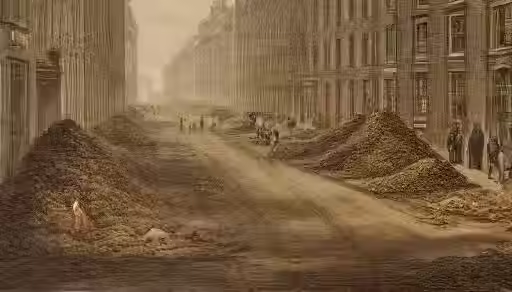Major Cities, Horse Manure, and Tesla: How Linear Thinking Misses Exponential Change
- Martin Sabag
- Jun 29
- 3 min read
A few days ago, Tesla did something never done before - a car left the factory in Texas, drove alone for 30 minutes on public roads at speeds up to 45 mph, and arrived at the customer's home. No driver, no remote supervision, cost to Tesla - $4.20 (!).
But let's go back a bit, to the beginning of the last century.
The Great Trouble of Manhattan and London
Back then, the biggest problem Manhattan and London faced was horse manure. Every morning, thousands of carriages, carts, and horse-drawn public transportation vehicles flowed into the centers of these cities. People rode horses, traveled in carriages, crowded into horse-drawn buses - and the horses, of course, produced a lot of manure.
Here are some numbers: In 1900 New York, there were between 100,000-200,000 horses. Each horse produces an average of 48 pounds of manure per day. This means Manhattan was flooded with over 2.5 tons of manure per day, plus about 26,000 gallons of urine.
In the evening, everyone returned to the suburbs, but the manure remained. How did they solve this? They sent more workers with more carts and more horses to clear the manure. Which produce, of course, more manure...
All entrepreneurship at that time focused on this problem: How to make horses defecate less? How to invent food that would make manure smell less? How to prevent manure from attracting flies and diseases?
In 1894, the London Times predicted: "In 50 years, every street in London will be buried under nine feet of manure." In 1898, the first international urban planning conference was held in New York - and it was stopped after just three days instead of the planned ten, because no one found a solution to the problem.
Tons of money, tons of research, tons of energy - everything was invested in dealing with the manure problem.
Then, less than two decades later, the problem disappeared.
Not because someone solved it. Simply because the horses disappeared. Cars appeared in their place.

I Wonder What Will Happen to My Harley-Davidson?
Will I, in 15-20 years, when all cars are fully autonomous, have to haul my motorcycle in a trailer to a special track to enjoy it? Just like today, if I want to ride a horse, I need to go to a farm or take it in a trailer to nature?
(OK, this doesn't really keep me up at night, but it's totally a point for thought, isn't it?...)
Why Do We Always Miss This?
The reason we don't see real changes coming is that we think linearly, but change is exponential.
When Tesla shows us a car that drives itself from factory to customer, most people see it as a cool feature. But it's not a feature - it's the beginning of a complete revolution in the transportation industry.
Linear thinking: "OK, so now they'll start doing this more and more, and it'll take 10-15 years until it's massive."
Exponential thinking: "If they can do this once now, within a year or two they'll do it dozens of times a day, and within 5 years the entire shipping and logistics industry will change completely."
What Doesn't Change? The Vision
But there's one thing that doesn't change (shouldn't at least anyway) in all these revolutions - the vision that drives companies.
Tesla's vision from day one was to accelerate the world's transition to sustainable transportation. Whether it's an electric car, robotaxi, or now autonomous delivery - everything serves the same vision.
This new autonomous delivery feature? It perfectly realizes this vision: reduces costs, improves efficiency, advances clean technology, and leads us to a future where transportation is less polluting and smarter.
The vision remains, only the ways to achieve it become more and more sophisticated and revolutionary.
Same thing at our level, the personal level. So maybe artificial intelligence, or new technologies will take our jobs or not, we can argue about that, but what definitely won't change is our WHY, only the ways to achieve it can change, sometimes drastically.
Our Challenge
Developing adaptability. Being agile in our lives, in our careers, in how we make a living. Understanding that the world changes at rates our brains aren't designed to handle.
But at the same time, staying connected to our core. Remembering what truly drives us and not getting lost in all the technological changes.
Because in the end, technology is just a tool. The question is what we do with it to realize who we really are.
What do you think? Where do you see yourselves in a world changing at exponential speed? And how do you maintain your why?








Comments